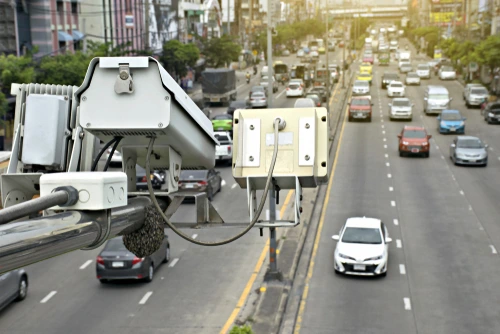
As our cities’ roads get busier and the volume of vehicles increases, it’s crucial that the safety features that are in place can keep up with this heightened demand. Transport agencies are responsible for helping to reduce the rates of accidents in cities, and this is achieved by incorporating a variety of traffic-calming measures into their infrastructure. We can expect to see greater rates of smart technology over the coming decades to help keep drivers safe in UK cities.

Here are five common features in cities that are designed to enhance driver safety.
Speed cameras
Some 27% of fatal collisions that took place in the UK in 2020 were caused by speeding. When vehicles travel at slower speeds, drivers have more opportunity to react to hazards, and braking distance is shorter. Plus, slow-moving vehicles exert less energy in the event of an impact, which means drivers and pedestrians are less likely to sustain serious injuries. Speed limits are vital for improving driver safety, but they work more effectively when speed cameras are used to enforce them. Research shows that speeding rates fall by 70% in sites with fixed speed cameras, and rates of serious injuries and fatalities fall by 50%.
Speed bumps
Speed bumps are raised, rounded bumps in the road that encourage drivers to slow down by making it uncomfortable and potentially dangerous to drive over them at fast speeds. Speed tables and speed cushions work in a similar way, but their size and shape make them suitable for use at junctions and on bus routes respectively. Most drivers maintain a speed of 15mph when travelling over speed bumps, drastically reducing the likelihood of a fatal accident occurring along that stretch of road.
Chicanes
Another common method for reducing speeding and enhancing driver safety in cities is the use of chicanes, also known as ‘priority narrowing’. This is where a raised curb and bollard are installed on one side of the road to force vehicles to give way to oncoming traffic. Chicanes are often installed in pairs or multiples with alternating priority so that vehicles travelling in both directions are forced to stop periodically for oncoming traffic. Not only do chicanes help to slow traffic down, but they can also help to encourage drivers to become more aware of their surroundings and potential hazards as they stop or slow down to give way.
Alternative road markings
It’s common for cities to use alternative road markings to calm traffic and reduce speeds with minimal disruption. Road markings can encourage drivers to proceed with caution, look out for hazards or position themselves more safely on the road. Peripheral hatching is where diagonal lines on the edge of the road reduce the width of the lane. This can help to reduce the sense of space available and encourage drivers to position themselves closer to the centre of the road. Many drivers subsequently slow down due to their closer proximity to oncoming traffic.
Another common tactic is to remove the centre line on two-way streets, particularly on relatively narrow roads or where there are lots of parked vehicles. By removing the sense of designated space for each direction of traffic, drivers are encouraged to slow down and keep a closer eye out for hazards in case an oncoming vehicle enters their path.
Traffic and parking monitoring systems
Traffic monitoring systems use sensors and cameras to continuously monitor the flow of traffic and collect data points like vehicle volumes, average speeds, the distance between vehicles and collision rates. Sometimes this data is used to support traffic planning and identify areas for new infrastructure to improve safety. It can also be used in real time to control traffic flow. For example, during quiet periods traffic lights might be switched off at large roundabouts to optimise flow and turned on at busy periods to reduce the risk of accidents.
Similar technology can be applied to parking spaces. Sensors installed either in the ground or overhead determine when parking spaces are occupied. Real-time data can then be displayed via digital signage to direct drivers away from full or near-full car parks and towards areas where there’s plenty of parking available. This helps to minimise congestion, cruising and idling of vehicles, and fewer cars on the roads means a reduced risk of accidents.
[Read more: The most dangerous roads in the UK for cyclists and pedestrians revealed]






